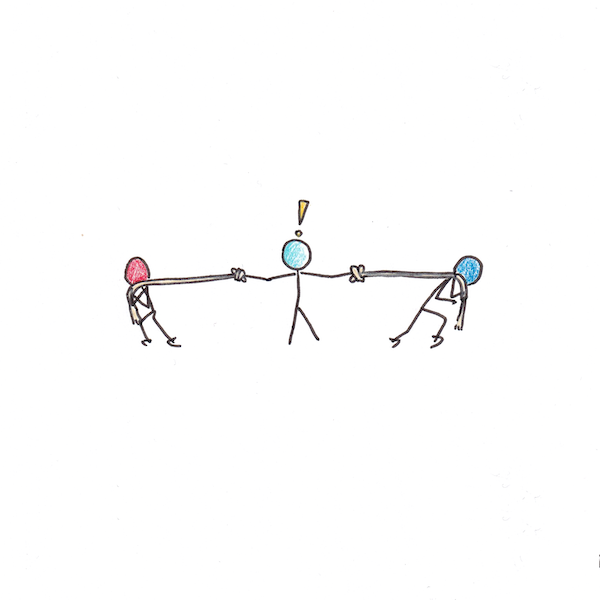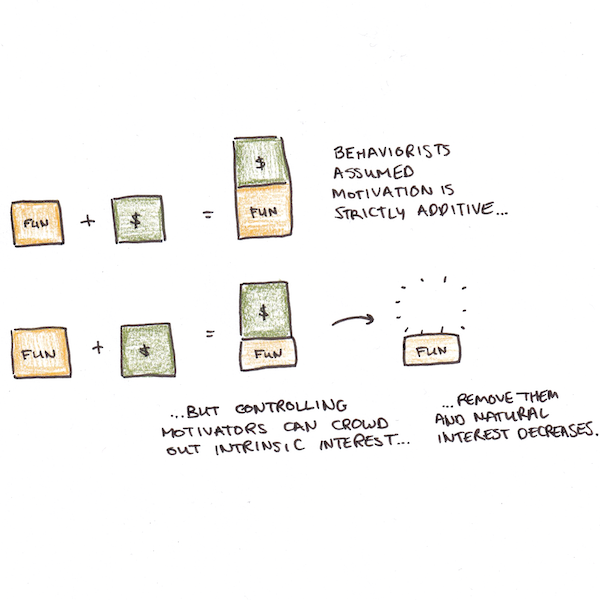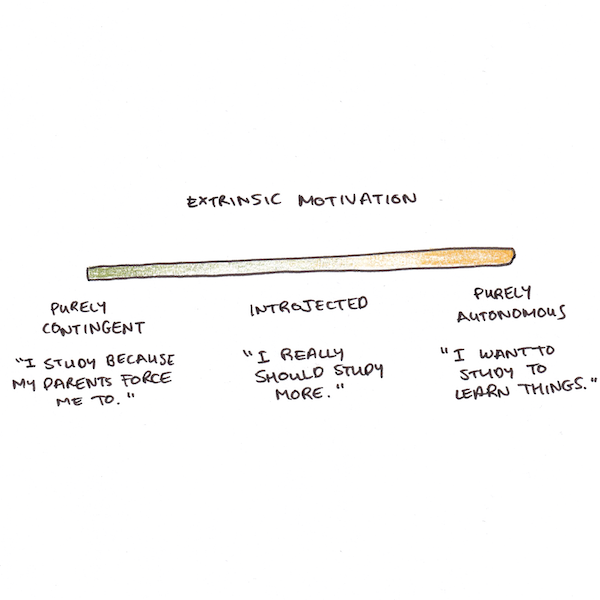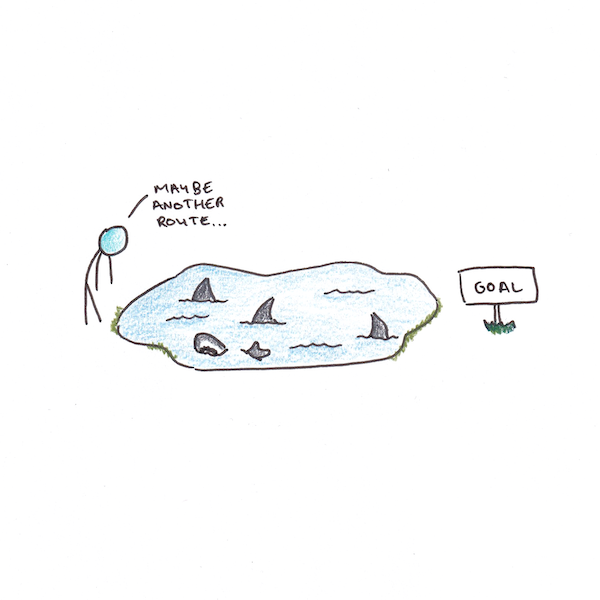In the last lesson, I introduced a simple metaphor for motivation: action always flows downhill. Thanks to the amazing circuitry in our basal ganglia, we take the billions of simultaneously firing neurons in our brain and produce sequential thoughts and actions.
Yet the choice of which action to take isn’t always the one our higher selves would opt for. Our motivational hardwiring is notoriously short-sighted, failing to spur us on for rewards that will take months and years to reach.

In this simplified account, one aspect I didn’t include was why our motivational terrain is what it is. Why do we find some actions harder to take than others? Why, in other words, do we struggle to motivate ourselves?
Push and Pull: Two Forces of Motivation
There are two different kinds of reasons we might fail to motivate ourselves:
- Lack of drive. This can be because the object of our goals just isn’t rewarding enough. Sometimes, we even trick ourselves about how genuine our motivation is (more on that later), and thus get “stuck” with goals that fail to inspire, but which we can’t drop to do something better.
- Pain from progress. Alternatively, there might be something particularly aversive in the way of our progress. This can be fears—as someone who wants to deliver a great speech but suffers from stage fright knows. But more commonly it’s drudgery, effort or boredom. We want to ace the exam, but grinding through problem sets just isn’t a lot of fun.
Importantly, it seems that these two factors of motivation can operate somewhat independently. Meaning, we can be in situations where we have few barriers, but relatively lackluster drive, and thus stall out. But, we can also be in situations where our goal is highly compelling, but an equally large pain prevents us from making progress.
Problems of Drive
It might seem paradoxical to talk about having a goal that you’re not really motivated to achieve. After all, if you didn’t really have much desire for the goal, why is it your goal in the first place?
One reason has to do with how motivation is shaped by reinforcement contingencies. In their pioneering work, Richard Ryan and Edward Deci, developed an experiment that contradicted decades of previous research on motivation.
Earlier behaviorist theories of motivation assumed all motivators were additive. If you give someone an extra reason to do something, their motivation ought to increase. This was backed by complicated theories that argued that motivation is simply the expression of past reinforcement. If you take an action, that is because of past reinforcement, end of explanation—consciousness, emotion and goals were unnecessary for understanding.
In his experiment on intrinsic motivation, Deci showed that rewarding someone for an enjoyable activity, say completing fun puzzles, did have the predictable effect on behavior—people did more puzzles.1 But, perversely, it diminished motivation after the experiment was complete. People did fewer puzzles for fun, afterward.

This experiment led the duo to propose self-determination theory as a more sophisticated model for human motivation. This theory says that it isn’t simply the rewards that count—our sense of autonomy over the actions we take matters too.
So what does this mean for a lack of drive? Ryan and Deci explain this elegantly too. In their system, externally motivated behavior operates on a spectrum, from purely instrumental activity we do only to get a particular reward, to all the partially-internalized motivators we feel guilt when we don’t always reach them, to those which are fully authentic and integrated into our personality.
This explains why goals can sometimes fail to motivate. If the impetus for a goal is a socially internalized norm “I need to get good grades” or “I should really exercise daily”, but doesn’t feel entirely self-generated, it can often provide only inconsistent motivation. Essentially, we’ll work at it enough to meet our appearance in the eyes of others, but often fail to pursue it vigorously enough to actually make real progress.

Spotting these pseudo-goals in oneself doesn’t always lead to a perfect solution. However, if you spot that your problem is that the motivation isn’t fully internalized, you can either work to make it more fully autonomous (injecting choice and control back into the domain, selling yourself on your goals, bringing it into alignment with other values) or you can push it back to work on something else.
Problems of Pain
The other reason we fail to motivate ourselves is because the pain of taking action can be too great. This may not always be literal pain, but fear, boredom, unpleasantness or drudgery.
As procrastination researcher Piers Steel notes in his literature review, task unpleasantness is one of the biggest associated factors with procrastination.2
While this isn’t earth-shatteringly surprising to realize, it too suggests ways we can improve progress on our goals. One is simply to redesign them to make them less unpleasant. If the problem is that your goal requires going forward with something you really don’t like, maybe you can do something you like more instead?

Another clue to resolving this problem comes from the psychology of phobias. Exposure therapy, in which you expose yourself gently to a fearful stimulus over time has a high effectiveness for reducing fears. To the extent that your aversion to making progress is due to an irrational fear or anxiety, applying a similar method can “ease” you into the work.
While it’s easy to think about pain in the most dramatic terms, it’s often the small pinches and itches that really derail progress. How many people fail to set up retirement accounts because the thought of trying to understand their 401k program makes them feel a bit anxious? How many get stuck in dead-end jobs because the thought of reaching out to talk to a few people in different career spaces feels awkward?
Motivation is a complex and fascinating topic. In Make it Happen!, we spend six weeks discussing motivational strategies for achieving your goals. Success comes from self-awareness. If you can understand the friction points holding you back, you can start to get results a lot faster.
I’ll open registration for a new session of Make it Happen! next week. On Sunday, I’ll share the final lesson in this warm-up series.
Footnotes
- Deci, Edward L. “Effects of externally mediated rewards on intrinsic motivation.” Journal of personality and Social Psychology 18, no. 1 (1971): 105.
- Steel, Piers. “The nature of procrastination: A meta-analytic and theoretical review of quintessential self-regulatory failure.” Psychological bulletin 133, no. 1 (2007): 65.


 I'm a Wall Street Journal bestselling author, podcast host, computer programmer and an avid reader. Since 2006, I've published weekly essays on this website to help people like you learn and think better. My work has been featured in The New York Times, BBC, TEDx, Pocket, Business Insider and more. I don't promise I have all the answers, just a place to start.
I'm a Wall Street Journal bestselling author, podcast host, computer programmer and an avid reader. Since 2006, I've published weekly essays on this website to help people like you learn and think better. My work has been featured in The New York Times, BBC, TEDx, Pocket, Business Insider and more. I don't promise I have all the answers, just a place to start.